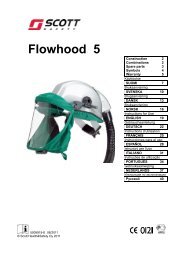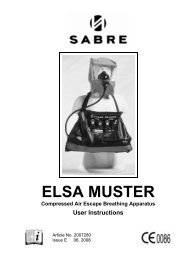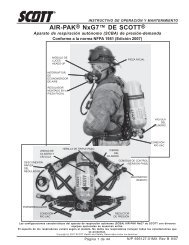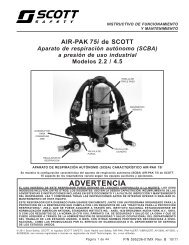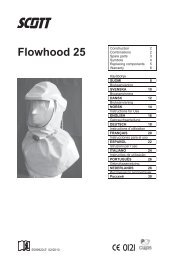7800 Controller - User Manual - Scott Safety
7800 Controller - User Manual - Scott Safety
7800 Controller - User Manual - Scott Safety
Create successful ePaper yourself
Turn your PDF publications into a flip-book with our unique Google optimized e-Paper software.
Model <strong>7800</strong> <strong>User</strong>s <strong>Manual</strong><br />
Revision E<br />
Figure 2.11<br />
• The Group menu entry offers additional flexibility by controlling which channels<br />
trip this menu’s common alarm relay. The 3 choices are 1-16, 1-8 or 9-16. Some<br />
applications have different types of sensors, or, sensors in different areas connected to<br />
the same MODEL <strong>7800</strong> <strong>Controller</strong>. In these cases, it may be undesirable for a sensor<br />
on channel 9 to trip the same relay as a sensor on channel 2. The Group menus may<br />
restrict this. For example, channels 1-8 might be set to trip common relay 1 while<br />
channels 9-16 trip common relay 2. Another possibility is channels 1-8 be set to trip<br />
common relay 1 while channels 9-16 trip relays on an optional discrete relay PCB<br />
configured for Alarm 1 (see section 3.2).<br />
• Failsafe controls relay activation for this common relay. Failsafe ON causes the<br />
relay to de-energize during alarm conditions and energize when there is no alarm.<br />
Thereby, a power failure forces the relay contact to the alarm position. Note the<br />
common Fault relay is always failsafe and may be monitored separately to indicate<br />
loss of power conditions in many applications.<br />
• A1 and A2 Votes allows creation of logical AND function equations that control<br />
common relay 1 & common relay 2. Default settings for common relay 1 are A1<br />
Votes = 01 and A2 Votes = 00 which causes relay 1 to trip if any channel has an<br />
A1 level alarm active. Default settings for common relay 2 are A1 Votes = 00 and<br />
A2 Votes = 01 which causes relay 2 to trip if any channel has an A2 level alarm<br />
active. Example: If either default setting is modified such that A1 Votes = 02 and<br />
A2 Votes = 01, then any two channels must have an A1 level alarm active and any<br />
one channel must have an A2 level alarm active to trip that relay. REMEMBER!<br />
One of the A1’s and the A2 could be on the same channel. These level alarms must<br />
come from a channel included in the Group entry described above.<br />
• Turning Acknowledge ON (not available on Alarm 1) allows the common relay to<br />
be deactivated during alarm conditions by an Alarm Reset. This is useful if an<br />
audible device is being driven by the relay.<br />
!<br />
All relays are rated at 5 Amp for 28 VDC and 250 ~VAC RESISTIVE loads.<br />
IMPORTANT: Appropriate diode (DC loads) or MOV (AC loads) snubber devices<br />
must be installed with inductive loads to prevent RFI noise spikes. Relay wiring<br />
should be kept separate from low level signal wiring.<br />
2.3.2 093-0269 DISCRETE RELAY “FAILSAFE” MODE<br />
093-0269 Discrete relay options may also be configured to function in a Failsafe mode<br />
using the System Setup menu shown in Figure 2.12. Entering YES causes these discrete<br />
<strong>Scott</strong> <strong>Safety</strong><br />
16<br />
087-0021 Rev F





